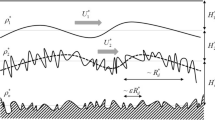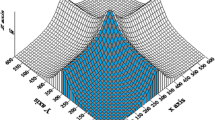Abstract
By using a linear symmetric Conditional Instability of Second Kind (CISK) model containing basic flow, we study the interactions between basic flow and mesoscale disturbances in typhoon. The result shows that in the early stage of typhoon formation, the combined action of vertical shear of basic flow at low level and CISK impels the disturbances to grow rapidly and to move toward the center of typhoon. The development of disturbances, likewise, influences on typhoon’s development and structure. Analysis of the mesoscale disturbances’ development and propagation indicates that the maximum wind region moves toward the center, wind velocity increases, and circulation features of an eye appear. Similarly, when a typhoon decays, the increase of low-level vertical wind shear facilitates the development of mesoscale disturbances. In turn, these mesoscale disturbances will provide typhoon with energy and make the typhoon intensify again. Therefore, it can be said that typhoon has the renewable or self-repair function.
Similar content being viewed by others
References
Chen Lianshou, Xu Xiangde, and Luo Zhexian, 2002: Introduction of Tropical Cyclone Dynamics. China Meteorological Press, Beijing, 317–318. (in Chinese)
Chen Yongsheng and M. K. Yau, 2003: Asymmetric structures in a simulated landfalling hurricane. J. Atmos. Sci., 60, 2294–2312.
Cheng Rui, Yu Rucong, Fu Yunfei, et al., 2011: Impact of cloud microphysical processes on the simulation of Typhoon Rananim near shore. Part I: Cloud structure and precipitation features. Acta Meteor. Sinica, 25(4), 441–455.
Corbosiero, K. L., M. John, and M. L. Black, 2005: The structure and evolution of Hurricane Elena (1985). Part I: Symmetric intensification. Mon. Wea. Rev., 133, 2905–2920.
—, —, R. A. Anantha, et al., 2006: The structure and evolution of Hurricane Elena (1985). Part II: Convective asymmetries and evidence for vortex Rossby waves. Mon. Wea. Rev., 134, 3074–3091.
Ding Deping and Li Ying, 2011: A study on typhooninduced rainfalls over Beijing: Statistics and case analysis. Acta Meteor. Sinica, 25(6), 742–753.
Ding Yihui, Zhang Jian, and Liu Yuezhen, 1986: Further analysis of Typhoon (197501)’s structure and dynamics. Acta Oceanologica Sinica, 8(1), 21–30.
Frank, W. M., and E. A. Ritchie, 2001: Effects of vertical wind shear on the intensity and structure of numerically simulated hurricanes. Mon. Wea. Rev., 129, 2249–2268.
Kepert, J. D., 2006: Observed boundary layer wind structure and balance in the hurricane core. Part I: Hurricane Georges. J. Atmos. Sci., 63, 2169–2193.
Lei Xiaotu and Chen Lianshou, 2005: A method to construct tropical cyclone wind distribution models and estimate its characteristic parameters. Chinese J. Geophy., 48(1), 25–31. (in Chinese)
Li Chongyin, Ye Duzheng, Huang Ronghui, et al., 1985: Introduction to Dynamic Meteorology. China Meteorological Press, Beijing, 225–226. (in Chinese)
Li Ying, Qian Chuanhai, and Chen Lianshou, 2009: A study on the eyewall expansion of Typhoon Sepat (0709) during its landfall process. Acta Meteor. Sinica, 67(5), 799–810. (in Chinese)
—, Chen Lianshou, Qian Chuanhai, et al., 2010: Study on formation and development of a mesoscale convergence line in Typhoon Rananim. Acta Meteor. Sinica, 24(4), 413–425.
Liu Yubao, Zhang Dalin, and M. K. Yau, 1999: A multiscale numerical study of Hurricane Andrew (1992). Part II: Kinematics and inner-core structures. Mon. Wea. Rev., 127, 2597–2615.
Lu Hancheng, Kang Jianwei, Kou Zheng, et al., 2004: Dynamics features of the mesoscale mixed wave in the typhoon. Natural Sciences Progress, 14, 541–547. (in Chinese)
Macafee, A. W., and M. P. Garry, 2006: Development and testing of tropical cyclone parametric wind models tailored for midlatitude application-preliminary results. J. Appl. Meteor. Climatol., 45, 1244–1260.
Reasor, P. D., and M. T. Montgomery, 2000: Lowwavenumber structure and evolution of the hurricane inner core observed by airborne dual-doppler radar. Mon. Wea. Rev., 128, 1653–1680.
Shea, D. J., and W. M. Gray, 1973: The hurricane’s inner core region. Part I: Symmetric and asymmetric structure. J. Atmos. Sci., 30, 1544–1564.
Tao Jianjun and Li Chaokui, 2009: The formation mechanism and evolution of the double piral arms in vortex. Acta Phy. Sinica, 58, 4313–4319. (in Chinese)
— and Xu Xianghui, 2012: The development and dissemination characteristic of disturbances in weak tropical cyclones. Acta Phy. Sinica, 61(16), 129202.2–129202.7. (in Chinese)
Wang Mingjun, Zhao Kun, and Wu Dan, 2011: The T-TREC technique for retrieving the winds of land-falling typhoons in China. Acta Meteor. Sinica, 25(1), 91–103.
Willoughby, H. E., 1978: The vertical structure of hurricane rainbands and their interaction with the mean vortex. J. Atmos. Sci., 35, 849–858.
—, H. L. Jin, S. J. Lord, et al., 1984: Hurricane structure and evolution as simulated by an axisymmetric nonhydrostatic numerical model. J. Atmos. Sci., 41, 1170–1186.
Author information
Authors and Affiliations
Corresponding author
Additional information
Supported by the National Natural Science Foundation of China (41075046).
Rights and permissions
About this article
Cite this article
Tao, J., Wang, F., Li, C. et al. Influence of vertical shear of basic tangential wind on the development and maintenance of typhoon. Acta Meteorol Sin 27, 273–281 (2013). https://doi.org/10.1007/s13351-013-0211-y
Received:
Accepted:
Published:
Issue Date:
DOI: https://doi.org/10.1007/s13351-013-0211-y




